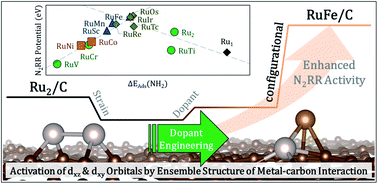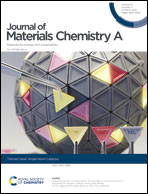Impact of the dopant-induced ensemble structure of hetero-double atom catalysts in electrochemical NH3 production†
Abstract
Using spin-polarized density functional theory (DFT) calculations, we examined electrochemical N2 reduction (N2RR) toward NH3 production on hetero-RuM (M = 3d transition metals) double atom catalysts supported on defective graphene by means of analysis on the geometric ensemble structure, the N2RR mechanism, the decoupling of strain, dopant and configurational effects and the d-orbital resolved density of states (ORDOS) (dz2, dxz, dyz, dxy, and dx2–y2) on the hetero-double atoms. In addition, we computationally screened novel catalysts by exploring 4d, 5d and p block metals as the hetero-M metals in the RuM system. First, we found the significantly enhanced N2RR activity of inclined pentagon M (Fe, Mn, and Sc) double atom catalysts (RuFe has the highest activity) compared to the homo-Ru2 double atom catalyst. Our DFT calculations on the interplay of strain, dopant and configurational effects in the inclined pentagon M (Fe, Mn, and Sc) double atom catalysts predicted that (1) the dopant effect was the promoter to improve the N2RR activity of RuSc and RuMn, (2) the tensile strain (RuSc) tended to reduce the NH3 productivity via the N2RR, while the effect of compressive strain (RuFe and RuMn) was insignificant, and (3) the dopant-support interaction induced a unique inclined pentagon M double atom ensemble structure, which leads to the large reduction of the N2RR activity of the hetero-RuSc double atom but the activity increases for the hetero-RuFe and RuMn cases. Finally, our DFT calculation on the analysis of the p–d (dz2, dxz, dyz, dxy, and dx2–y2) orbital overlap identified the key d orbitals in determining the descriptor (NH2 adsorption energy) for representing the N2RR. That is, the orbitals (dz2, dxz, and dyz) having an orientation toward the z direction in the horizontal Ru2 double atom played an important role in determining the NH2 adsorption process, while for the inclined pentagon M double atoms (RuFe, RuSc, and RuMn), the dxz and dxy orbitals were found to be essential for the modification of NH2 adsorption energy. Finally, a descriptor based DFT search additionally discovered promising hetero-RuOs and RuIr double atom catalysts. This study highlights that the dopant engineering of hetero-double atom catalysts supported on defective graphene can significantly modify the electrochemical reactivity, particularly by the dopant type and geometric ensemble structure.

- This article is part of the themed collection: Single-Atom Catalysis


 Please wait while we load your content...
Please wait while we load your content...